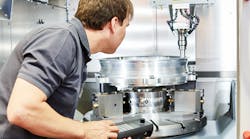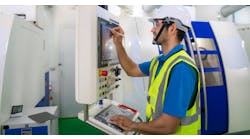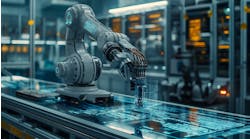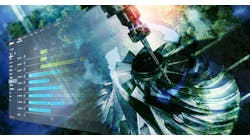EAM and CMMS are two of the most common systems for manufacturing asset management and maintenance. While the two systems have some things in common, there are some major differences in functions and capabilities. CMMS is focused on work at the plant level, while EAM is implemented more broadly, across the enterprise.
To get the best results from your EAM or CMMS, you must first know how each one works – and how they differ.
What is a CMMS?
CMMS stands for Computerized Maintenance Management System. As the name suggests, it focuses primarily on maintenance management. CMMS keeps track of maintenance data for all the assets and also helps to automate it through communication for maintenance activities.
In a plant, CMMS plays the role of an efficient communication system for the maintenance manager. Some of its central features are keeping asset information databases, automating maintenance scheduling, managing work orders, and streamlining inventory. The maintenance scheduling feature of a CMMS is central to preventive maintenance at any plant.
CMMS collaborates with different plant systems to create approval workflows and automate maintenance-related tasks. Work-order management in a CMMS reduces paperwork for maintenance tasks and helps to create a thorough database with a history of asset maintenance. It helps managers communicate the priority of a work order quickly, to get a maintenance task performed as soon as possible.
Essentially, CMMS claims to improve maintenance management in multiple ways to improve asset service life and reduce unplanned downtime.
What is an EAM System?
The label, Enterprise Asset Management, explains the system quite well, as it focuses on managing assets to achieve high productivity and reduce unplanned downtime. An EAM system helps the plant get the most out of the assets from the time they’re brought into the system until they are replaced. In a way, EAM is a parent system that includes all the CMMS features and many others to maximize plant productivity.
Almost all EAM systems come with a dedicated module for asset lifecycle management. This module handles the task of managing assets based on their age. For example, a CNC lathe that is older than others will respond differently to the same workload and will need more care. It may require a higher frequency of maintenance, more replacement plans, upgrades, and keeping track of efficiency. This way, EAM helps management detect which assets are returning value for the resources spent on them.
It is important to point out that EAM systems have improved much over recent years. In today’s market, there are some significant differences between traditional and modern EAM systems: Modern EAM systems are cloud-based and easy-to-use compared to the unwieldy, traditional EAM systems: The quick access to data and intuitive interfaces make the modern EAM system an indispensable tool for the employees, one that makes their work easier.
Differences between EAM and CMMS
As mentioned, EAM and CMMS have major differences in their areas of focus and capabilities. CMMS has limited functionality because its sole goal is to manage the maintenance of the installed assets in the system. On the other hand, EAM systems come with various business functions along with asset management for their entire service life, starting from design and installation.
EAM and CMMS have common features like work-order management, inventory management, preventive maintenance, and customizable configuration. Although both systems provide these features, EAM systems provide better transparency, smarter maintenance scheduling, and a range of customizations that are crucial for large enterprises.
Modern EAM systems are smarter and intuitive, with multiple features that help managers and employees run the plant efficiently through better asset utilization. It offers an application program interface (API) to improve services visibility and accelerate the implementation, while a CMMS must be integrated with an API. EAM also offers greater scalability compared to CMMS because of its features that can be expanded to include more assets easily.
The unique features of EAM software include features like fleet management, warranty tracking, MRO, and data visualization. EAM systems often have better report creating features due to the large amount of data from various assets and areas of manufacturing compared to a CMMS.
Another important attribute is that EAMs’ multiple locations and availability of IT maintenance departments make them a better choice for larger enterprises. CMMS is more suitable for single-site enterprises with small-scale operations.
EAM systems are different because of their users, too: While a CMMS is used by maintenance and operations workers directly, an EAM also has users in C-suites, accounting, compliance team, resource allocation, and others.
Getting the most from your CMMS
To get the most out of your CMMS, you first must choose a suitable system. When choosing a CMMS, you should focus on the type of assets in the plant and their maintenance needs rather than just the CMMS features. Even after you’ve found a CMMS, using it effectively depends on its users – maintenance and operators workers – so they should be trained not simply to use the CMMS but to apply all its features to improve the quality of plant maintenance and productivity.
For example, a CMMS comes with a work-order management module that delivers all the maintenance information to technicians. However, it needs to be preferred by technicians over other forms of communication to help improve engagement. CMMS’s warranty tracking and inventory management features also play a crucial role in reducing maintenance costs and optimizing the inventory of the plant.
Using all the features of a CMMS should be part of workers’ standard operating practices (SOP), to avoid system underuse. Creating regular reports for various features of a CMMS can help determine where the plant can make better use of the system and improve results.
Getting the most from your EAM system
Everything detailed here applies equally to an EAM system. Like a CMMS, you have to choose an EAM system that suits your requirements first, and then you have to train the employees to engage its full potential.
What’s especially important with an EAM system is that the employees embrace the system that they have to work with every day. When they know every function and options of the system, they find effective ways to get things done without being intimidated by it. To make sure the employees know the system well, an expert from the IT department should be assigned to set it up and train the employees.
Then, managers should use asset data to make production and maintenance decisions. Data visualization also highlights the priority of different focus areas, and helps to avoid overlooking high-priority areas. EAM system codes like work order (WO) types, WO class, maintenance delay, machine failure, and inventory classes are vital for asset management KPIs, and should be reviewed regularly based on results.
Finally, EAM reports can provide insights into the usage of the system and should be studied thoroughly.
Choosing an EAM or CMMS system for your plant requires assessing the needs and doing the research to determine which system provides the most benefits for your operations and processes. Once you’ve chosen and installed the system that suits your plant’s needs, the goal should be to get the most out of its features. A suitable asset and maintenance management system improves plant efficiency and productivity with better management capabilities. Never settle for a system that is not worker-friendly and cannot keep up with the growth of your enterprise.
Eric Whitley is Director of Smart Manufacturing with L2L, a Cloud-based software for use solving factory floor problems in real-time, reducing downtime, improving response time to production issues, and reducing overall maintenance costs.







